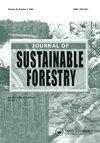变化检测、森林冠层密度和森林破碎化的估算与分析——以印度孙德尔本斯为例
IF 1.8
4区 农林科学
Q3 FORESTRY
引用次数: 0
摘要
本文根据印度孙德尔本斯森林密度的变化,利用模糊c均值算法将卫星影像分为4类。分类为茂密森林、疏林、水体和湿地。研究表明,净森林面积从1975年的932平方公里减少到2018年的847平方公里,减少了3.75%,森林砍伐率为每年1.96平方公里。相关统计结果表明,森林被砍伐地区向湿地和水体转化。森林冠层密度(FCD)模型结果显示,森林冠层密度为60-100%的区域从1975年的42% (939 km2)逐渐下降到2018年的36% (814 km2)。1990年和1975年的冠层密度最大值分别为80 ~ 80%和60 ~ 80%。森林破碎化模型的结果表明,森林斑块和边缘面积分别增加了253%和28%,而孔洞林面积缓慢减少,减少了11%。森林破碎化主要发生在斑块林、边缘林、孔洞林和核心林,面积约为40km2。因此,本研究对监测印度孙德尔本斯红树林土地覆盖变化具有一定的指导意义。本文章由计算机程序翻译,如有差异,请以英文原文为准。
Estimation and Analysis of Change Detection, Forest Canopy Density, and Forest Fragmentation: A Case Study of the Indian Sundarbans
ABSTRACT In this paper, satellite imagery is classified into four categories using the fuzzy c-means algorithm of the Indian Sundarbans due to its forest density changes. The categories are dense forest, sparse forest, water bodies, and wetlands. The study reveals that net forest areas declined by 3.75% from 932 km2 in 1975 to 847 km2 in 2018 and the rate of deforestation was 1.96 km2 year−1. The correlation statistic shows that the deforested areas were converted to wetland and water bodies. The results of the forest canopy density (FCD) model show that areas, with canopy density of 60–100% gradually declined from 42% (939 km2) in 1975 to 36% (814 km2) in 2018. Moreover, we also observed that maximum canopy density was >80% in 1990 and 60–80% in 1975. The results of the forest fragmentation model show that forest patch and edge areas progressively increased by 253% and 28%, respectively, while perforated forest areas slowly decreased with 11%. We find that most forest fragmentation happened in patch, edge, perforated, and core forest with an area >4 km2. Therefore, this study may be helpful in monitoring land cover changes of the Indian Sundarbans for sustainable mangrove forests.
求助全文
通过发布文献求助,成功后即可免费获取论文全文。
去求助
来源期刊

Journal of Sustainable Forestry
Social Sciences-Geography, Planning and Development
CiteScore
3.90
自引率
12.50%
发文量
42
期刊介绍:
Journal of Sustainable Forestry publishes peer-reviewed, original research on forest science. While the emphasis is on sustainable use of forest products and services, the journal covers a wide range of topics from the underlying biology and ecology of forests to the social, economic and policy aspects of forestry. Short communications and review papers that provide a clear theoretical, conceptual or methodological contribution to the existing literature are also included in the journal.
Common topics covered in the Journal of Sustainable Forestry include:
• Ecology, management, recreation, restoration and silvicultural systems of all forest types, including urban forests
• All aspects of forest biology, including ecophysiology, entomology, pathology, genetics, tree breeding, and biotechnology
• Wood properties, forest biomass, bioenergy, and carbon sequestration
• Simulation modeling, inventory, quantitative methods, and remote sensing
• Environmental pollution, fire and climate change impacts, and adaptation and mitigation in forests
• Forest engineering, economics, human dimensions, natural resource policy, and planning
Journal of Sustainable Forestry provides an international forum for dialogue between research scientists, forest managers, economists and policy and decision makers who share the common vision of the sustainable use of natural resources.
 求助内容:
求助内容: 应助结果提醒方式:
应助结果提醒方式:


